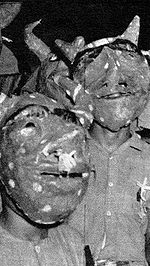
Dancing Devils of Yare
Encyclopedia

San Francisco de Yare
The city of San Francisco de Paula de Yare is the capital of the Simón Bolívar Municipality. It is located in the Middle Tuy Valley, approximately south of Caracas....
, Miranda
Miranda (state)
Miranda State is one of the 23 states into which Venezuela is divided. It is ranked second in population among Venezuelan states, after Zulia State. In June 30, 2010, it had approximately 2,987,968 residents. It also has the greatest Human Development Index in Venezuela, according to the...
state, Venezuela
Venezuela
Venezuela , officially called the Bolivarian Republic of Venezuela , is a tropical country on the northern coast of South America. It borders Colombia to the west, Guyana to the east, and Brazil to the south...
, at the Corpus Christi
Blessed Sacrament
The Blessed Sacrament, or the Body and Blood of Christ, is a devotional name used in the Roman Catholic Church, Eastern Catholic Churches, Old Catholic, Anglican, and Lutheran churches, to refer to the Host after it has been consecrated in the sacrament of the Eucharist...
day. The Sociedades del Santísimo (Societies of the Holiest) are in charge of the celebration. Its origins are traced back to the 18th century, being the oldest brotherhood of the American continent.
Every Corpus Christi (nine Thursdays after Holy Thursday), a ritual dance is performed by the so called "Dancing Devils", who wear colorful garments (commonly all red), layers of stripped fabric, masks of grotesque appearance and also accessories like crosses, scapulars, rosaries and other sorts of amulets.
The fraternity of the devils is divided in hierarchical order, represented in their masks.
There are other expressions of this particular festivity named according to the location, such as the Devils of Naiguatá and the Devils of Chuao.
Procession and dress code

Later on, they move towards the front of the church and when mass is ended, the Eucharist is placed at the church's entrance and a sort of fight representation begins between the devils and the guardians. Finally, the devils surrender and kneel in front of the Eucharist to show submission, dancing then to the rhythm of the bamba, a music style that is more reverential. The entire performance represents the victory of Good over Evil. The dancing devils wear a red shirts, trousers and stockings, a mask depicting a devil, and canvas sandals. They carry a cross made out of blessed palm leafs, a rosary, and a medallion with the image of Christ (that can be substituted by another Christian
Christian
A Christian is a person who adheres to Christianity, an Abrahamic, monotheistic religion based on the life and teachings of Jesus of Nazareth as recorded in the Canonical gospels and the letters of the New Testament...
religious image). They also carry in one hand a devil-shaped maraca and in the other a whip.

